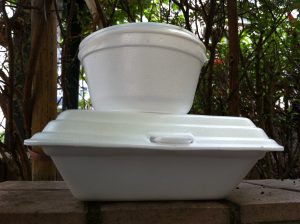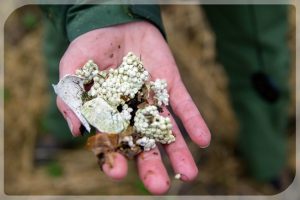Polystyrene, we see it nearly every day, often blown into hedgerows and tumbling out of bins after a Saturday night. It keeps our takeaways hot, insulates our homes and safely transports everything from fresh fish to TVs, and even human organs, all around the world. What a hero! Yet, the devastation it reaps on our natural environment is far from heroic.

Polystyrene, takeaway packaging is proving problematic
Polystyrene is a kind of plastic. Like other plastic, when polystyrene is littered or leaks out of supply chains it can harm wildlife and last for years and years. Made from chemicals that come from oil and gas, styrene is one of the main ingredients and is a suspected health hazard. Expanded polystyrene (EPS) and Extruded polystyrene (XPS) are both materials which might be familiar to you by the name ‘polystyrene’, or the trademark ‘Styrofoam’. Often, these polystyrene materials are used to make boxes for the transportation of products that need to have a regulated temperature, for example to keep food warm or cool and to protect breakable items. With so many uses of polystyrene perhaps it is not surprising it keeps cropping up in Fidra’s work to address environmental issues in everything from salmon farming to our work on disposable, takeaway food packaging [1]. But there are alternatives available.
The facts…
Around 22 million [2] polystyrene fish boxes are used each year to transport the UK’s wild caught and farmed fish to the restaurants we eat in and the supermarkets we shop at. Further, in 2017, Keep Britain Tidy reported that 23% of all litter recorded was food and food packaging related [3], a considerable amount of which would have had a polystyrene base. The funny thing? That we can understand why it is used so widely! Polystyrene protects produce from impact damage; keeps fish fresh and cool, and your chips warm; is low in cost and weight making it cheap to buy and transport; does not absorb scents and in theory can be reused and recycled.
Diving Deeper: Is polystyrene too good to be true?
On the face of it, polystyrene may look like an ideal packaging material but a little digging reveals this cheap material has high environmental and climate costs throughout its production, use and disposal. In 2018, the total global oil consumption stood at 99.2 million [4] barrels each day. With 0.01% [5] of this oil (just under 10,000 barrels) going directly on the production of polystyrene products, it has a very significant climate and environmental impact. In addition, the US National Research Council’s 2011 National Toxicology Program confirmed that styrene, the precursor of polystyrene, was “reasonably anticipated to be a human carcinogen” [6], and therefore a potential occupational health hazard. Studies have shown that styrene can leach out of products into the food and drink they contain and as both EPS and XPS contain styrene, this presents an additional hazard to human health [7].

Polystyrene from the marine environment.
After use, polystyrene has an environmental impact as a major component of terrestrial and marine litter. Surveys conducted by the Marine Conservation Society highlight that it is a consistent component of coastal litter [8], with an average of 182.6 pieces of plastic or polystyrene turning up on every 100m of beach surveyed. Finally, a further concern surrounds the number of compounds and chemicals which are incorporated during production as these can enter the environment either by leaching or through degradation of the material [9] [10].
Can we kick the habit?
It may seem that we use polystyrene so often that we could never find a suitable replacement. Yet, businesses are finding numerous solutions to limit the negative environmental and health implications that polystyrene presents. Below are a number of packaging alternatives that we have been exploring:
Reusable
Most of the negative impacts come from both the production and disposal of expanded polystyrene due to the use of fossil fuels and leaching of chemicals in landfill. Therefore, where facilities are available, some companies are prioritising washing and reusing fish boxes, made from either polystyrene or hard plastics, to keep them in the supply chain and increase and improve their resource efficiency. When going for your Friday night takeaway, why not take your own box so you don’t need to use the famous polystyrene villain, the chippie clamshell? In the UK, West Ham United and London Stadium[11] are trialling a reusable cup systems with internal collection points at matches, whilst startup CupClub [12] provides a returnable packaging service which is currently used in cafes across London with plans to roll out to airports and cities. Elsewhere, places like Freiburg and Bern, have set up their own city-wide reusable systems for takeaway food and drink: check out the FreiburgCup [13] and Bern’s Bring Back Box [14].
Compostable
Compostable packaging often uses raw and/or post-consumer natural materials. This means that such packaging can be disposed of with food waste and ultimately made into compost to be used on soils. One US business, Vericool Packaging [15], has developed a product which meets industry standards allowing it to be disposed of in either a domestic composting or recycling waste stream. For takeaways, UK based Vegware provides compostable packaging and cutlery as well as their Close the Loop[16] collection system to ensure all products are appropriately treated.
Recyclable
As a nation, the UK is familiar with recycling both its domestic and industrial waste, recognising the benefits and ease of doing so. As a result, some companies feel that this is the best solution for limiting packaging waste.
Plastic:
Tri-pack’s [17] trademark product, CoolSeal, is specifically designed for cold chain transportation and all products are made with polypropylene which can be fully and easily recycled.
Board:
Aware of the environmental problems associated with polystyrene, Finnish fish company Kalaneuvos [18], packages their fish in corrugated board boxes. The wood fibre is sourced from renewable Finnish sites, is watertight and fully recyclable.
What can you do?
Whilst the responsibility of removing polystyrene from within our supply chains does indeed lie with our businesses through their supplier and transporting decisions, we as individuals can still have a considerable, positive impact.
- If you decide to have a takeaway make sure you take your own boxes, cutlery and cups with you. Most places will happily fill your receptacles.
- If you’ve made a spontaneous trip and don’t have a box on you, don’t worry, why not ask to just have your food wrapped in paper?
With a growing global awareness of the impact of single use plastic packaging on the environment, Fidra is asking companies and communities to examine their use of polystyrene and consider how our products can be contained in a more environmentally sustainable way. Polystyrene is everywhere. Sometimes you see it, like when it is keeping your takeaway warm sometimes you don’t like when it is tucked into your walls for insulation. But it is there, tonnes of it. The problem is that some of it, a lot if it, is escaping. Polystyrene is running away to sea to start a new and long life as a marine pollutant. Washing up on our beaches, reaching into the inside of turtles filling the stomachs of seabirds. Polystyrene is everywhere. We think polystyrene should only be in the places where you really need it and should be reused and recycled when it is used. A lot of the time polystyrene can be replaced with safer alternatives, this will cut the damage polystyrene does in production, in use and on disposal.
[1] https://www.fidra.org.uk/projects/food-packaging/
[2] http://www.eps.co.uk/adayinthelifeofafishbox/index.html
[3] https://www.gov.uk/government/publications/litter-and-littering-in-england-2016-to-2017/litter-and-littering-in-england-2016-to-2017
[4] https://www.statista.com/statistics/271823/daily-global-crude-oil-demand-since-2006/
[5] https://www.bpf.co.uk/plastipedia/polymers/expanded-and-extruded-polystyrene-eps-xps.aspx
[6] National Toxicology Program, Department of Health and Human Services: Report on Carcinogens, Fourteenth Edition. https://ntp.niehs.nih.gov/ntp/roc/content/profiles/styrene.pdf
[7] Yanagiba, Y., Ito, Y., Yamanoshita, O. & Nakajima, T. (2008) Styrene trimer may increase thyroid hormone levels via down-regulation of the Aryl hydrocarbon Receptor (AhR) target gene UDP-glucuronosyltransferase. Environmental Health Perspectives, 116, 740-745.
[8] Marine Conservation society, 25th Great British Beach Clean 2018 Report
[9] Manalac et al (2010) Leaching behaviour of sulfonated polystyrene (SPS) from recycled Styrofoam. International Journal of Environmental Science and Development, 1(4), 368-370.
[10] Rani et al (2014) Hexabromocyclododecane in polystyrene based consumer products: An evidence of unregulated use. Chemosphere, 110.
[11] https://www.whufc.com/news/articles/2019/march/14-march/west-ham-calls-fans-passonplastic
[12] https://cupclub.com/page/services
[13] https://zerowasteeurope.eu/2018/09/coffee-to-go-freiburg-says-tschuss-to-single-use-cups/
[14] https://friendsoftheearth.uk/plastics/plastic-takeaway-packaging
[15] www.vericoolpackaging.com
[16] https://www.vegware.com/close-the-loop/info_50.html
Tags: environment, plastic, plastic pollution, Polystyrene, single-use plastic, takeaway
